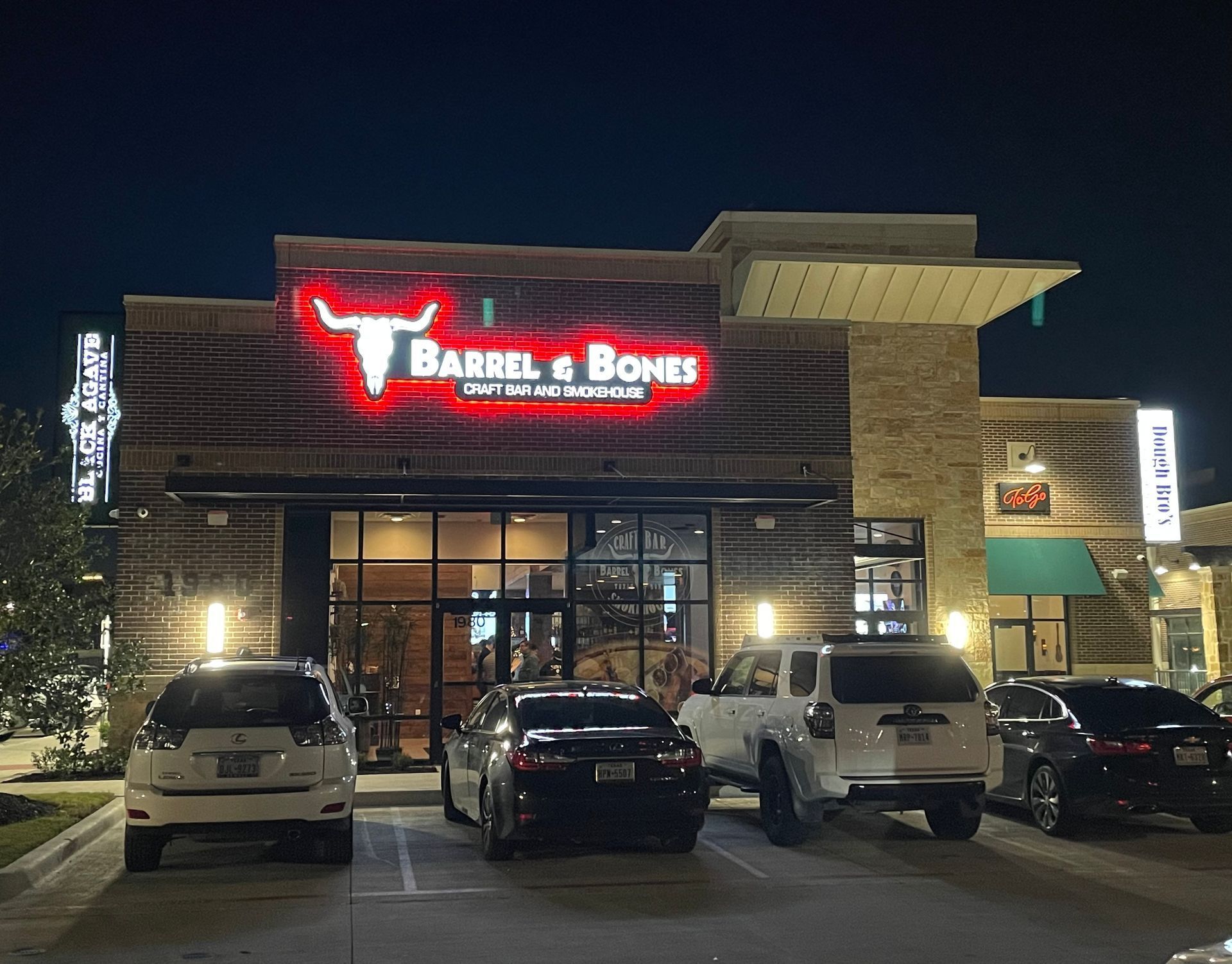Crafting an Impactful Building Sign: A Guide to Design Excellence
January 20, 2024
January 20, 2024
Building signs play a crucial role in establishing a business's identity and creating a memorable impression on potential customers. An effective building sign design goes beyond aesthetics; it communicates your brand message, attracts attention, and enhances visibility. This article explores and outlines key elements that contribute to an impactful building sign design, including color and font selection, as well as the optimal size for maximum visibility.
Building signs play a crucial role in establishing a business's identity and creating a memorable impression on potential customers. An effective building sign design goes beyond aesthetics; it communicates your brand message, attracts attention, and enhances visibility. This article explores and outlines key elements that contribute to an impactful building sign design, including color and font selection, as well as the optimal size for maximum visibility.
What makes an effective building sign design?
a. Clarity and Simplicity: An effective building sign design should convey its message clearly and concisely. Avoid clutter and overly complex designs that may confuse or overwhelm viewers. Focus on a simple yet powerful representation of your brand, ensuring that passersby can quickly grasp the essential information. b. Brand Consistency: Maintaining consistency with your brand elements is crucial. Incorporate your logo, colors, and any other visual elements that define your brand identity. Consistency helps reinforce brand recognition and makes your business more memorable. c. Readability: Ensure that the text on your building sign is easily readable from a distance. Choose clear and legible fonts, and consider the viewing angles from various distances and perspectives. Test readability in different lighting conditions to guarantee visibility during day and night. d. Visibility: Consider the location of your building sign. Ensure that it is strategically placed for maximum visibility. Factors such as nearby structures, traffic flow, and lighting conditions should be taken into account to optimize visibility. How do I choose the right colors and fonts for my building sign? a. Color Psychology: Colors evoke emotions and convey messages. Choose colors that align with your brand personality and the emotions you want to elicit in your audience. Consider the contrast between background and text colors to enhance readability. b. Font Selection: Select fonts that reflect your brand's personality and are easy to read. Avoid overly decorative or complex fonts that may hinder legibility. Additionally, consider the scalability of the font to maintain readability across different sign sizes. b. Contrast: Ensure sufficient contrast between text and background colors to enhance visibility. High-contrast combinations improve readability, making your building sign more effective, especially from a distance. What size should my building sign be for optimal visibility? a. Proportional to Viewing Distance: The size of your building sign should be proportional to the distance from which it will be viewed. Consider factors such as the height of the building, surrounding structures, and the speed of passing traffic to determine the optimal size for maximum impact. b. Local Regulations: Your sign company will check local regulations and guidelines regarding building signage size. Compliance with these regulations is essential to avoid legal issues and ensure that your sign is well-received within the community. Crafting an effective building sign design involves a thoughtful consideration of clarity, brand consistency, readability, color psychology, and optimal size. By paying attention to these key elements, your sign will not only enhance visibility but also leave a lasting impression on your target audience.
a. Clarity and Simplicity: An effective building sign design should convey its message clearly and concisely. Avoid clutter and overly complex designs that may confuse or overwhelm viewers. Focus on a simple yet powerful representation of your brand, ensuring that passersby can quickly grasp the essential information. b. Brand Consistency: Maintaining consistency with your brand elements is crucial. Incorporate your logo, colors, and any other visual elements that define your brand identity. Consistency helps reinforce brand recognition and makes your business more memorable. c. Readability: Ensure that the text on your building sign is easily readable from a distance. Choose clear and legible fonts, and consider the viewing angles from various distances and perspectives. Test readability in different lighting conditions to guarantee visibility during day and night. d. Visibility: Consider the location of your building sign. Ensure that it is strategically placed for maximum visibility. Factors such as nearby structures, traffic flow, and lighting conditions should be taken into account to optimize visibility. How do I choose the right colors and fonts for my building sign? a. Color Psychology: Colors evoke emotions and convey messages. Choose colors that align with your brand personality and the emotions you want to elicit in your audience. Consider the contrast between background and text colors to enhance readability. b. Font Selection: Select fonts that reflect your brand's personality and are easy to read. Avoid overly decorative or complex fonts that may hinder legibility. Additionally, consider the scalability of the font to maintain readability across different sign sizes. b. Contrast: Ensure sufficient contrast between text and background colors to enhance visibility. High-contrast combinations improve readability, making your building sign more effective, especially from a distance. What size should my building sign be for optimal visibility? a. Proportional to Viewing Distance: The size of your building sign should be proportional to the distance from which it will be viewed. Consider factors such as the height of the building, surrounding structures, and the speed of passing traffic to determine the optimal size for maximum impact. b. Local Regulations: Your sign company will check local regulations and guidelines regarding building signage size. Compliance with these regulations is essential to avoid legal issues and ensure that your sign is well-received within the community. Crafting an effective building sign design involves a thoughtful consideration of clarity, brand consistency, readability, color psychology, and optimal size. By paying attention to these key elements, your sign will not only enhance visibility but also leave a lasting impression on your target audience.


June 27, 2025
LED signs, with their vibrant displays and dynamic capabilities, have become a top choice for businesses looking to stand out. One of the most common questions business owners ask is: What are the operational costs of LED signs? This blog post dives into the key factors affecting the operational costs of LED signs for storefront businesses, helping you make an informed investment decision. Why Choose LED Signs for Your Storefront? LED signs are renowned for their bright, customizable displays that can showcase promotions, brand messages, or even animated content. Unlike traditional neon or fluorescent signs, LED signs offer superior energy efficiency and durability. Upfront costs of purchasing and installing an LED sign can vary (typically $4,000 to $10,000 or more depending on size and features), but the ongoing operational costs are also a consideration for business owners. Let’s break down these costs. Key Operational Costs of LED Signs One of the standout benefits of LED signs is their energy efficiency. LED technology consumes significantly less power than other signage options. On average, an LED sign uses about 5 watts per square foot, compared to 30-50 watts for neon or fluorescent signs. For a typical 20-square-foot storefront LED sign running 12 hours a day, you might use approximately 100 watts per hour, or 1.2 kWh daily. Cost Estimate: Assuming an average electricity rate of $0.14 per kWh (based on U.S. commercial rates in 2025), the daily cost is roughly $0.17, or about $5 per month. For larger signs or longer operating hours, costs scale accordingly, but LED signs remain far less expensive to run than older technologies. LED signs are built for durability, with a lifespan of 50,000 to 100,000 hours (approximately 6-12 years at 12 hours daily). Their solid-state design means fewer moving parts and less wear compared to neon or fluorescent signs, which require frequent bulb or gas replacements. Final Thoughts: Are Static LED Signs Worth It? For storefront businesses, LED signs offer a compelling mix of affordability and impact. With operational costs as low as $4-$10 per month for electricity and minimal maintenance, they’re a budget-friendly way to enhance your storefront’s appeal. Their long lifespan and energy efficiency expenses make them a smart investment for small businesses, from cafes to retail shops. Ready to light up your storefront? At SIGMA Sign Co. we specialize in LED signs and can manage all aspects of the sign process including, design, permitting, installation, and maintenance. Contact us today to get started on creating a powerful, energy efficient sign that makes your business stand out!

March 27, 2025
At SIGMA Sign Co., we understand that installing an outdoor sign is a crucial step in promoting your business. However, the permitting process can be complex and time-consuming. With our expertise, our team will simplify this process for you by navigating the permitting process successfully for you. Step 1: Understanding Local Regulations Each city and municipality has unique regulations regarding outdoor signage. These rules may include restrictions on size, height, lighting, and placement. Our team is familiar with local codes and can help you determine the requirements for your area. We'll work with your local zoning or building department to ensure your sign meets all regulations. Step 2: Preparing Detailed Plans Our design experts will create detailed plans that align with your brand vision and meet permitting requirements. These plans typically include: Sign dimensions and design details Materials to be used Proposed installation location Electrical requirements (if applicable) We provide clear visuals such as mockups, blueprints, and site photos to ensure a smooth approval process. Step 3: Submitting Your Permit Application SIGMA Sign Co. can handle the entire permit application process for you. This often requires: Contractor registration A completed permit application form Detailed site and design plans Proof of property ownership or landlord approval Engineering certification (if required) We'll also take care of the permit fee process, which varies depending on your location and project scope. Step 4: Engaging with Local Authorities In some cases, city officials may request adjustments to your design. Our team will stay in close communication with authorities to ensure your project moves forward without delays. If required, we'll attend zoning board or council meetings to advocate for your sign's approval. Step 5: Scheduling Inspections Once your permit is approved, SIGMA Sign Co. will manage the inspection process to ensure your sign complies with safety codes and local regulations. We’ll coordinate inspections during and after installation for a seamless experience. Step 6: Partnering with SIGMA Sign Co. Choosing SIGMA Sign Co. means you’re working with experienced professionals dedicated to delivering compliant, high-quality signage. We take the hassle out of the permitting process, so you can focus on growing your business. Final Thoughts Navigating the permitting process doesn't have to be overwhelming. At SIGMA Sign Co., we specialize in managing all aspects of sign design, permitting, and installation. Contact us today to get started on creating a powerful sign that makes your business stand out!

By 7015546988
•
March 27, 2025
When designing logos, signs, or other graphics for your business, you may hear the term "vector file." But what exactly is it, and why is it important? A vector file is a type of graphic file that uses mathematical equations to create lines, shapes, and curves. Unlike pixel-based images (like JPEG or PNG), vector files are scalable without losing quality. Because vector files are mathematical, machine tool paths can be programed allowing signs to be cut and or bent into dimensional components. Vector art also ensures your logo will stay crisp and sharp whether it's printed on a business card or a billboard. Why Choose Vector Files? Perfect for Scaling: Need your logo on a storefront sign or a vehicle wrap? Vector files allow you to resize your design without it becoming pixelated or blurry. Smaller File Size: Vector files often take up less storage space than high-resolution raster images. Easy to Edit: Vector graphics can be modified quickly, allowing designers to adjust colors, shapes, and text with precision. Common Vector File Formats .SVG (Scalable Vector Graphics) – Ideal for web graphics. .AI (Adobe Illustrator) – A common format for professional design work. .EPS (Encapsulated PostScript) – Often used for large-scale printing. .PDF (Portable Document Format) – Can maintain vector properties when saved correctly. Why Does It Matter for Your Signage? Using vector files ensures your sign is sharp, professional, and scaled to fit your space. Whether you're showcasing your brand on a storefront, vehicle, or banner, vector files are key to achieving amazing results. If you're investing in professional signage, make sure your designs are created in vector format — it's the best way to ensure your brand looks its best at any size!


